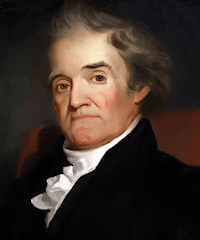
Figure
FIG'URE, noun fig'ur. [Latin figura, from figo, to fix or set. See Feign.]
1. The form of any thing as expressed by the outline or terminating extremities. Flowers have exquisite figures. A triangle is a figure of three sides. A square is a figure of four equal sides and equal angles.
2. Shape; form; person; as a lady of elegant figure
A good figure or person, in man or woman, gives credit at first sight to the choice of either.
3. Distinguished appearance; eminence; distinction; remarkable character. Ames made a figure in Congress; Hamilton, in the cabinet.
4. Appearance of any kind; as an ill figure; a mean figure
5. Magnificence; splendor; as, to live in figure and indulgence.
6. A statue; an image; that which is formed in resemblance of something else; as the figure of a man in plaster.
7. Representation in painting; the lines and colors which represent an animal, particularly a person; as the principal figures of a picture; a subordinate figure
8. In manufactures, a design or representation wrought on damask, velvet and other stuffs.
9. In logic, the order or disposition of the middle term in a syllogism with the parts of the question.
10. In arithmetic, a character denoting a number; as 2. 7. 9.
11. In astrology, the horoscope; the diagram of the aspects of the astrological houses.
12. In theology, type; representative.
Who was the figure of him that was to come. Romans 5:14.
13. In rhetoric, a mode of speaking or writing in which words are deflected from their ordinary signification, or a mode more beautiful and emphatical than the ordinary way of expressing the sense; the language of the imagination and passions; as, knowledge is the light of the mind; the soul mounts on the wings of faith; youth is the morning of life. In strictness, the change of a word is a trope, and any affection of a sentence a figure; but these terms are often confounded.
14. In grammar, any deviation from the rules of analogy or syntax.
15. In dancing, the several steps which the dancer makes in order and cadence, considered as they form certain figures on the floor.
FIG'URE, verb transitive fig'ur.
1. To form or mold into any determinate shape.
Accept this goblet, rough with figured gold.
2. To show by a corporeal resemblance, as in picture or statuary.
3. To cover or adorn with figures or images; to mark with figures; to form figures in by art; as, to figure velvet or muslin.
4. To diversify; to variegate with adventitious forms of matter.
5. To represent by a typical or figurative resemblance.
The matter of the sacraments figureth their end.
6. To imagine; to image in the mind.
7. To prefigure; to foreshow.
8. To form figuratively; to use in a sense not literal; as figured expressions. [Little Used.]
9. To note by characters.
As though a crystal glass the figured hours are seen.
10. In music, to pass several notes for one; to form runnings or variations.
FIG'URE, verb intransitive To make a figure; to be distinguished. The envoy figured at the court of St. Cloud.